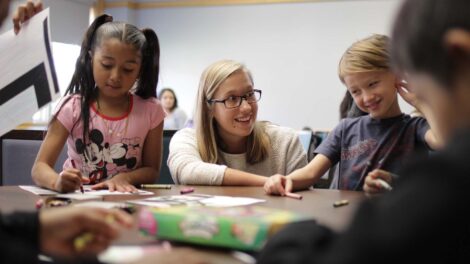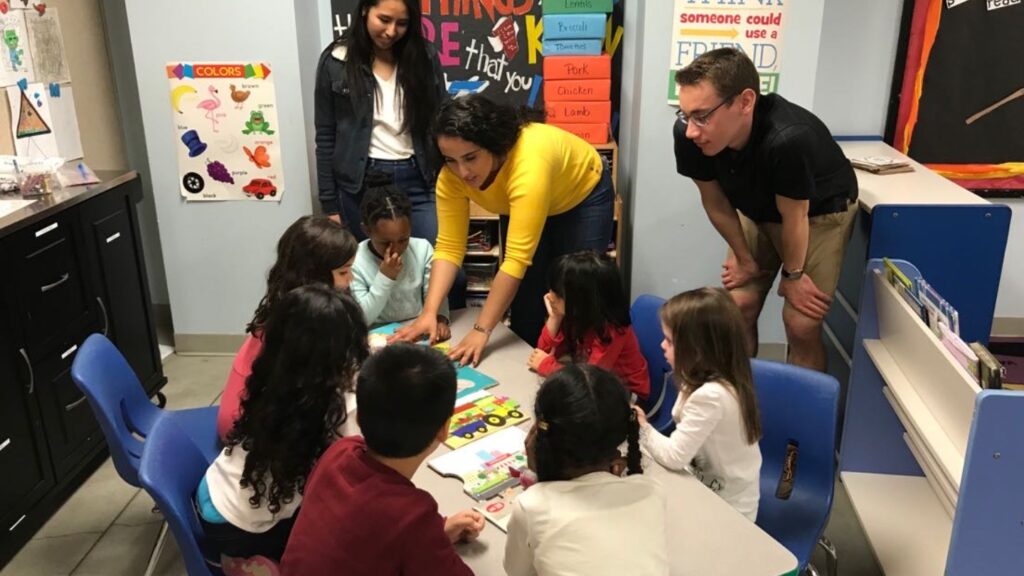Campus & Community

Landis Center for Community Engagement
Fostering community-based learning and research activities at Lafayette College through partnerships between campus and Easton community
Alums share how the Landis Center program opened opportunities for innovative teaching and learning
By Bryan Hay
Liszeth Rodriguez-Meza ’21 still remembers with vivid detail the excitement and curiosity bubbling up from Paxinosa Elementary School students during a Connected Classrooms program in 2018.
“While at times they did become distracted, they still benefited from our lesson because they walked away learning the concepts of turbidity, conductivity, and water pollution,” she recalls.
“I know this because after the lab procedure that we did with them, my partners and I asked them a series of questions,” Rodriguez-Meza says. “Which liquid had the highest turbidity and which had the highest conductivity? What kind of taste does a liquid with high conductivity have? What is an example of a nonpoint source pollution?
“The students were able to answer all of these questions, and it was just amazing to see how they understood topics that we were learning in our Intro to Environmental Engineering course,” she remembers.
In collaboration with Easton Area School District, the Landis Center’s Connected Classrooms program engages more than 600 students and 15 faculty members in experiential learning opportunities each year.
Connected Classrooms promotes college and career awareness, exploration, and readiness among Easton area students, with the goal of presenting opportunities for innovative teaching and learning to Lafayette faculty and students.

Diana De La Torre ’20 helps deliver a Connected Classrooms unit at Easton YMCA (pre-pandemic).
For alumni who have seen how Connected Classrooms widens eyes and stimulates young minds, it’s an experience that won’t soon be forgotten.
“As college students, and specifically engineering students, we benefited from this program because we had to brainstorm ways in which we could present difficult and complicated concepts to an audience that does not necessarily have the same educational background as we do,” Rodriguez-Meza says.
“We had to adapt to their way of thinking and had to come up with ways to explain them in a manner that was engaging and easy to understand,” she adds. “This may seem like it is a simple task, but I remember my team brainstormed a lot to come up with creative ways to teach these topics. The entire experience was very rewarding because we walked away knowing that we were able to teach them something that they did not know before.”
Patrick Halpin ’21 was inspired to join Connected Classrooms by his mom’s experiences and advice as a teacher.
“I can remember her explaining that students this age are much more willing to listen to the advice of college-age students as opposed to older adults,” he says.
Connected Classrooms is not only extremely beneficial to the Easton Area School District community, but it’s also a valuable opportunity for the Lafayette community to participate in it as well, Halpin says.
Lafayette students benefit from the opportunities to explain the basics of complex subjects by deploying fun and engaging exercises to a young, impressionable audience and tout the importance of attaining a higher education at the same time.
“To these students we are not just Lafayette College students, but rather we are seen as celebrities, almost like superheroes, and we instantly gain their undivided attention,” Halpin says.
Many of the young students ask what it’s like to attend a school like Lafayette and quickly determine to do whatever it takes to one day get there, he adds.
“It is my hope that to this day these students still remember what we discussed and are constantly striving to achieve their end goal of higher education,” Halpin says.
Diana De La Torre ’20, who manages a Chicago youth program, credits Connected Classrooms for helping her present complex issues to children.
A Connected Classrooms module on the environmental implications of preparing a hamburger has stuck with her. Children reacted to all the steps that go into making and delivering hamburgers—the bun, the tomato, the beef, the storage and transportation of the individual ingredients.
“They came to the realization that there’s much more to the popular food than buying it at the grocery store,” she recalls. “It was a complex idea with multiple steps that we had to simplify and help them understand that the closer you are to home when you purchase food, like at a farm stand, the smaller your carbon footprint is.”
In her work managing the Back of the Yards Neighborhood Council, De La Torre says she often turns to her Connected Classrooms experience to find ways that she can connect with organizations that are environmentally conscious and help children get involved with them.
Connected Classrooms allows Lafayette students to connect with and form a lasting bond with the community, Halpin adds.
“This was a great way to give back to the Easton area community,” he says. “As a student at Lafayette College, it is easy to put on blinders and not look around at the areas outside the boundaries of College Hill.
“It is always a rewarding feeling to see that you have had such a major impact on another person’s life,” Halpin says. “My hope is that these students are continuing to remember what we discussed about the importance of always working as hard as you can and always looking to achieve higher and higher in everything that they do.”

Fostering community-based learning and research activities at Lafayette College through partnerships between campus and Easton community